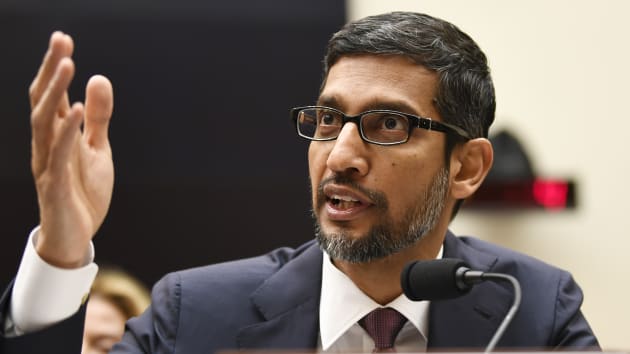
FANG became FANG out of sense of the inevitable dominance of Facebook, Amazon, Netflix and Google, operators of winner-take-most platforms running the consumer Internet.
Now — as FANG has sputtered, with the stocks sitting 7% to 35% below their peak prices in a market within 3% of a record high — analysts and investors are resorting to estimates of the companies’ “break-up value,” or sum-of-the-parts analysis, to argue the stocks are a good value.
Not long after the market began recognizing these companies’ power and rewarding them with premium valuations, CNBC’s Jim Cramer coined the FANG acronym more than five years ago in a brilliant stroke of stock-market taxonomy.
The stocks went on to appreciate at several times the rate of the broad market and FANG became shorthand for an entire investing style of owning the anointed winners of the connected economy.
But if inevitable dominance and near-effortless growth is what won this group acclaim and earned investors riches, such attributes are now attracting scrutiny and threats from politicians and regulators.
This antitrust pressure applies mostly to Facebook, Google parent Alphabet and Amazon. (Netflix, which was always the smallest and more focused player, after all buys its product at full price and competes with financially potent and entrenched media incumbents.)
Not much has changed for the underlying businesses of the largest FANG players, aside from heavy spending by Facebook to build up its content- and privacy-policing functions.
But with the stocks receding from their leadership role and the news of policy threats echoing around the market, Wall Street has increasingly taken to highlighting the value of individual pieces of these companies not fully reflected in their present valuations.
Valuing tech’s parts
Last week, Deutsche Bank analyst Lloyd Walmsley argued that Alphabet’s Google Cloud Partners division could be worth an eye-catching $225 billion. That would amount to more than a quarter of Alphabet’s $840 billion market capitalization, for a business that’s a distant third in cloud services and is generating a small fraction of the company’s overall revenue.
The report immediately prompted others to speculate on what towering value Amazon Web Services would command if that analysis were close to correct. AWS has nearly 50% market share and will book nearly four-times GCP revenue next year, even assuming Google gains ground fast, according to Jefferies analysts. By the Deutsche Bank math, is AWS’s implied value the vast majority of Amazon’s $860 billion market cap?
Needham analyst Laura Martin recently posited that Alphabet’s YouTube alone could be worth $200 a share and Android App Store another $100 a share, with autonomous-driving startup Waymo, Gmail and other pieces representing other unappreciated assets. The stock now trades just above $1,200, and Martin arrives at a potential $1,600 stock if the company were busted up.
RBC Capital analyst last week spotlighted Googles Maps as an under-monetized source of added growth for the company, a key reason he raised his share-price target to $1,500 from $1,425. This isn’t a breakup call, but shows Wall Street’s current focus on mining the secondary businesses of FANG companies to support valuation projections.
And of course every time, the idea of breaking apart Facebook into Instagram, Messenger, WhatsApp and core Facebook, analysts and fund managers assert that the collection could be worth more than the current whole. The example of AT&T’s long-atop breakup is typically invoked, which did unleash greater value along with more vigorous competition.
For good reason, few expect a mandated or voluntary move to carve up these tech giants. The antitrust legal case is disputable, the path long in any case.
These companies are all led by founders, who have tried to keep their companies paranoid and entrepreneurial, nurturing or buying new ventures funded by the dominant core products, to position themselves for an unknowable future. Spinning off the assembled or organically built pieces would run against their deeply held visions, no doubt.
Other tech companies, such as Barry Diller’s Interactive Corp., have serially spun off businesses after they reach scale, from Expedia to LendingTree to Match.com. But that was the approach all along. Hewlett-Packard-Packard split itself into two a few years ago, but from a position of weakness with multiple low-growth legacy businesses.
Wall Street hype?
The fact that analysts are proposing such sum-of-parts methodology could be viewed cynically as a Wall Street maneuver to bolster estimates of the stocks’ value, to sing the same bullish tune in a different key.
Perhaps the good news for investors is that’s the stocks’ valuations have indeed ebbed quite a bit over the past couple of years, whether because of regulatory opposition or simply longer-term growth trends moderating.
Facebook is down to about 20-times the next 12 months’ forecast earnings, from closer to 30 a couple of years ago,. Alphabet’s P/E similarly is at 23-times from the high 20s – even without adjusting for its enormous cash trove or potential transactions.
Even Amazon, a company not run for per-share earnings as a goal, is trading at around 30-times free cash flow now, down from more than 50-times at its peak $1 trillion market cap last year.
So even if the companies stay intact without radical business-model changes, the risk-reward for today’s investors might have improved.





























